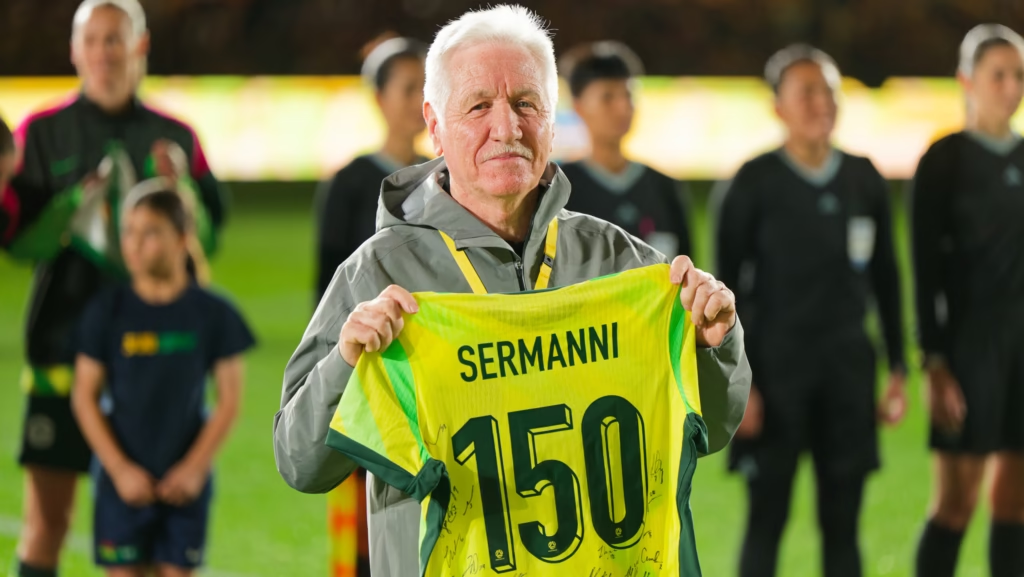
Tom Sermanni prior to the Matildas vs Argentina game in Melbourne, being presented with a commemorative jersey to mark his 150th game in charge of the Matildas. Photo: Marcus Robertson/Round Ball Australia
Tom Sermanni first arrived in Australia football in 1983 as a player for the Marconi Stallions, before moving to Canberra and into the coaching ranks in 1988 as a player/coach before moving into coaching full-time.
His resume in the decades since has seen him take roles all over Australia and the world, including stints with the Matildas on three separate occasions, Japan with Sanfreece Hiroshima, the US Women’s National Team, and Orlando Pride to name a few different stops.
His recent interim stint as Matildas coach finally came to an end with a win on Monday, as Joe Montemurro was announced that morning as the new coach for the side.
Sermanni himself said in his final press conference that he expected to be done with the role by Christmas last year, but he stayed the course until Football Australia found who they were after.
With 151 ‘A’ international matches coached to his name, amongst all of his other roles in Australian football over the years, he is one of the greatest servants the game has ever had.
But what exactly is Sermanni’s legacy in Australian football?
Is it the formation of the W-League (now known as the A-League Women) in 2008, of which he had a massive input? Is it the 2010 Asian Cup win? Is it the vast array of coaching stints he’s had both here and overseas in a post-playing career that started in the late 1980’s?
Or could it actually be all of the above and then some, that most people won’t actually be able to quantify into something solid because you can’t tangibly assess his wide-arching impact across everyone his influence has touched in Australian football?
Whatever the answer actually is, Sermanni deliberately avoided using the term legacy to describe it.
“If I were to say what I think my… contributions were, I think the NTC (National Training Centre) programs, because they were the ones in that period that [between] 2006 to 2012, and a bit further on, produced the players, the Sam Kerr’s, the Caitlin Foord’s,” he said.
“We had great coaches in place, we had a great system in place. I think that was one of the things, if I look back, that we created that I feel was really beneficial.
“The second thing was the W-League. I think the W-League’s been really instrumental in giving opportunities to domestic players who might not have had opportunities if we didn’t have that league.”
With Sermanni having been critical of the domestic game prior to the first game against Argentina in this window, calling the state of the A-League Women “not good enough”, it emphasised the fact that he used his platform to showcase his passion for the game in this country and get people talking about the important subjects.
With a crowd of 25,125 at GIO Stadium on Monday who all cheered Michelle Heyman, the question was posed to Sermanni on how to get all those people to McKellar Park to watch Canberra United.
“I keep harping on about three things that need to happen in women’s sport. One is the media need to give it better coverage or more coverage,” Sermanni said.
“Sponsors need to come on-board and realise that there is actually, when you see this tonight, there’s a great market there that’s untapped in women’s football.
“And people need to come along to the games. McKellar Park should be full. We need to see young girls, families, and people coming along and supporting the domestic players in the league.
“Those are the three things that need to happen.”
Ultimately, Sermanni’s legacy is so far-stretched across Australian football, it’s hard to scratch the surface on it, but if the only thing he is remembered for is his three stints as Matildas coach and the creation of the W-League, he will always be remembered within Australian football, and that is probably the best legacy one can ask for.
Listen to the latest episode of The Dubcast, Round Ball Australia’s Women’s Football podcast on Spotify, Apple, or watch on YouTube, with new episodes every Wednesday.
